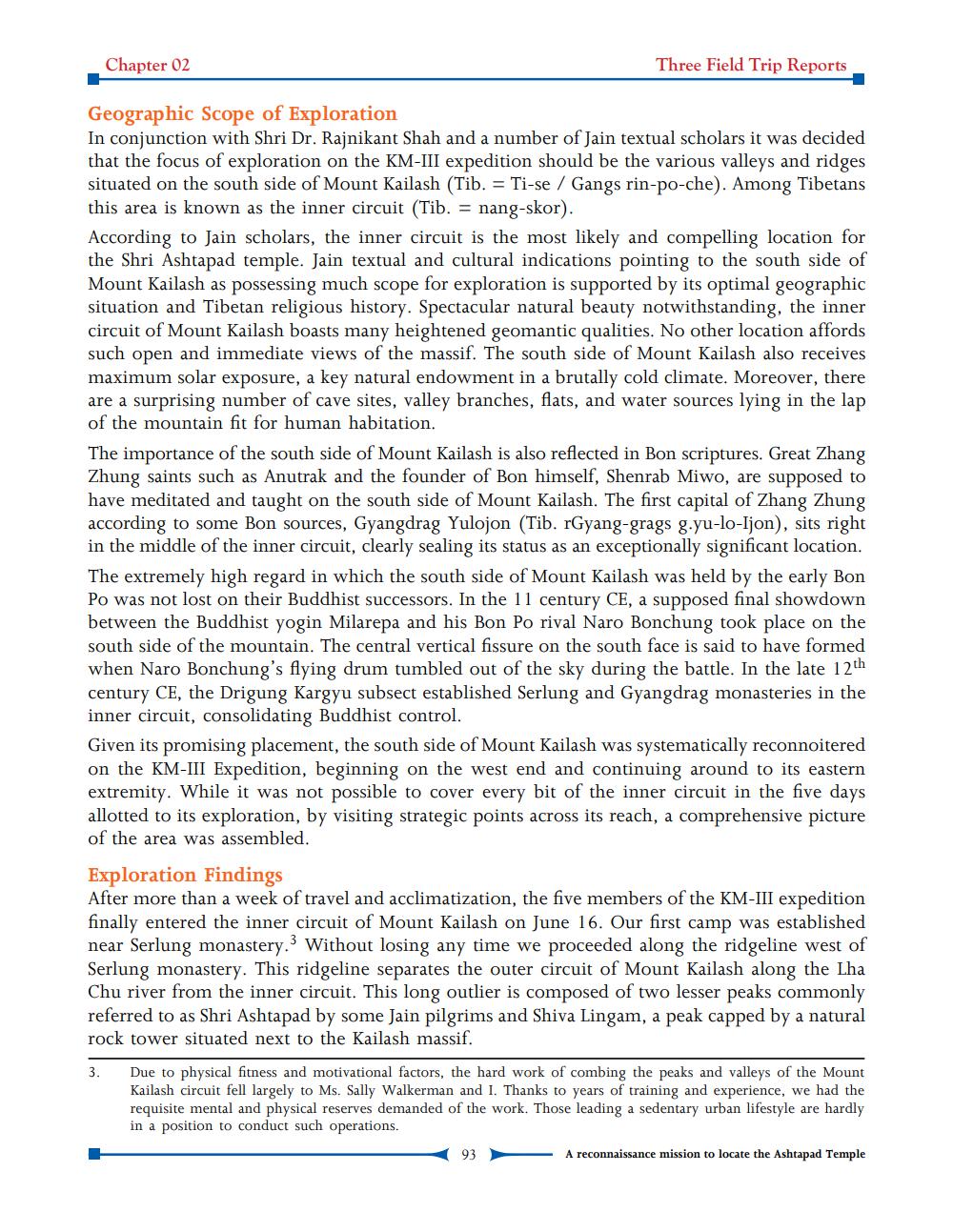________________
Chapter 02
Three Field Trip Reports
Geographic Scope of Exploration In conjunction with Shri Dr. Rajnikant Shah and a number of Jain textual scholars it was decided that the focus of exploration on the KM-III expedition should be the various valleys and ridges situated on the south side of Mount Kailash (Tib. = Ti-se / Gangs rin-po-che). Among Tibetans this area is known as the inner circuit (Tib. = nang-skor). According to Jain scholars, the inner circuit is the most likely and compelling location for the Shri Ashtapad temple. Jain textual and cultural indications pointing to the south side of Mount Kailash as possessing much scope for exploration is supported by its optimal geographic situation and Tibetan religious history. Spectacular natural beauty notwithstanding, the inner circuit of Mount Kailash boasts many heightened geomantic qualities. No other location affords such open and immediate views of the massif. The south side of Mount Kailash also receives maximum solar exposure, a key natural endowment in a brutally cold climate. Moreover, there are a surprising number of cave sites, valley branches, flats, and water sources lying in the lap of the mountain fit for human habitation. The importance of the south side of Mount Kailash is also reflected in Bon scriptures. Great Zhang Zhung saints such as Anutrak and the founder of Bon himself, Shenrab Miwo, are supposed to have meditated and taught on the south side of Mount Kailash. The first capital of Zhang Zhung according to some Bon sources, Gyangdrag Yulojon (Tib. rGyang-grags g.yu-lo-ljon), sits right in the middle of the inner circuit, clearly sealing its status as an exceptionally significant location. The extremely high regard in which the south side of Mount Kailash was held by the early Bon Po was not lost on their Buddhist successors. In the 11 century CE, a supposed final showdown between the Buddhist yogin Milarepa and his Bon Po rival Naro Bonchung took place on the south side of the mountain. The central vertical fissure on the south face is said to have formed when Naro Bonchung's flying drum tumbled out of the sky during the battle. In the late 12th century CE, the Drigung Kargyu subsect established Serlung and Gyangdrag monasteries in the inner circuit, consolidating Buddhist control. Given its promising placement, the south side of Mount Kailash was systematically reconnoitered on the KM-III Expedition, beginning on the west end and continuing around to its eastern extremity. While it was not possible to cover every bit of the inner circuit in the five days allotted to its exploration, by visiting strategic points across its reach, a comprehensive picture of the area was assembled.
Exploration Findings After more than a week of travel and acclimatization, the five members of the KM-III expedition finally entered the inner circuit of Mount Kailash on June 16. Our first camp was established near Serlung monastery. Without losing any time we proceeded along the ridgeline west of Serlung monastery. This ridgeline separates the outer circuit of Mount Kailash along the Lha Chu river from the inner circuit. This long outlier is composed of two lesser peaks commonly referred to as Shri Ashtapad by some Jain pilgrims and Shiva Lingam, a peak capped by a natural rock tower situated next to the Kailash massif.
Due to physical fitness and motivational factors, the hard work of combing the peaks and valleys of the Mount Kailash circuit fell largely to Ms. Sally Walkerman and I. Thanks to years of training and experience, we had the requisite mental and physical reserves demanded of the work. Those leading a sedentary urban lifestyle are hardly in a position to conduct such operations.
93
A reconnaissance mission to locate the Ashtapad Temple




